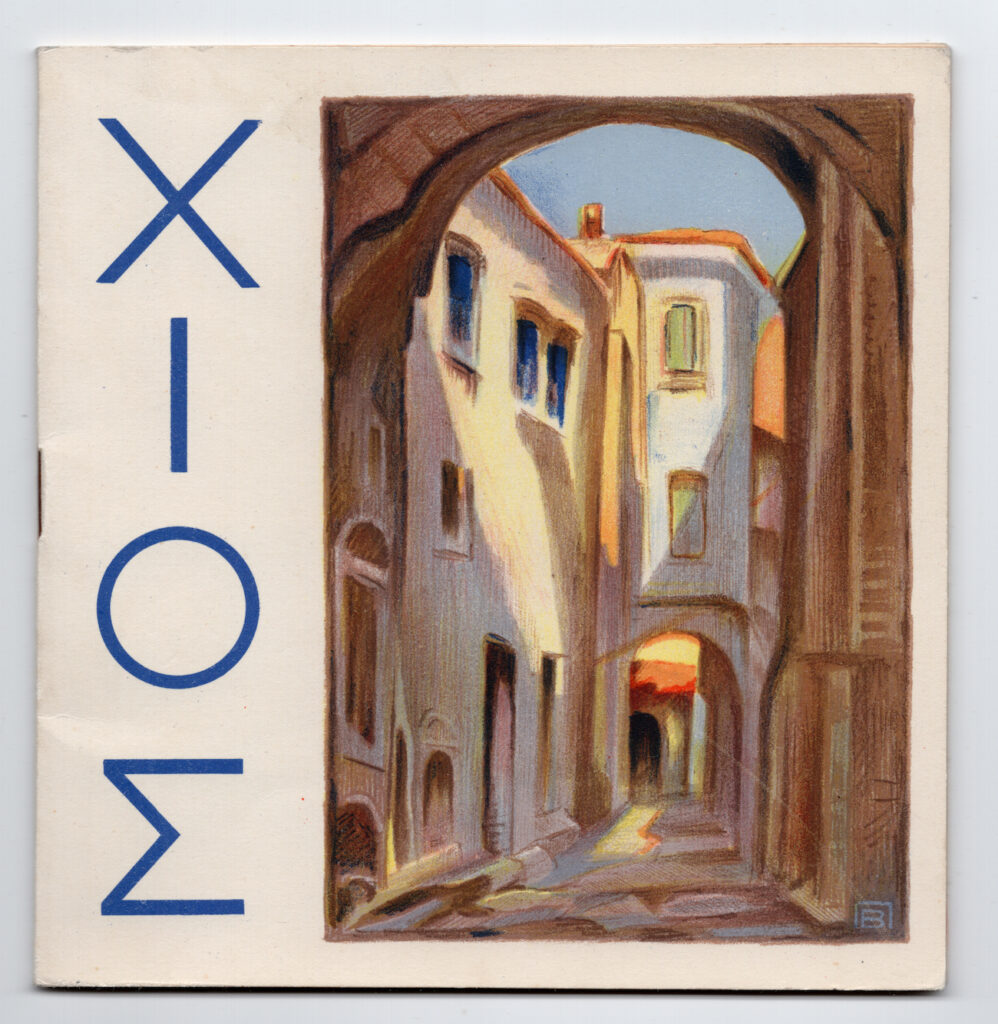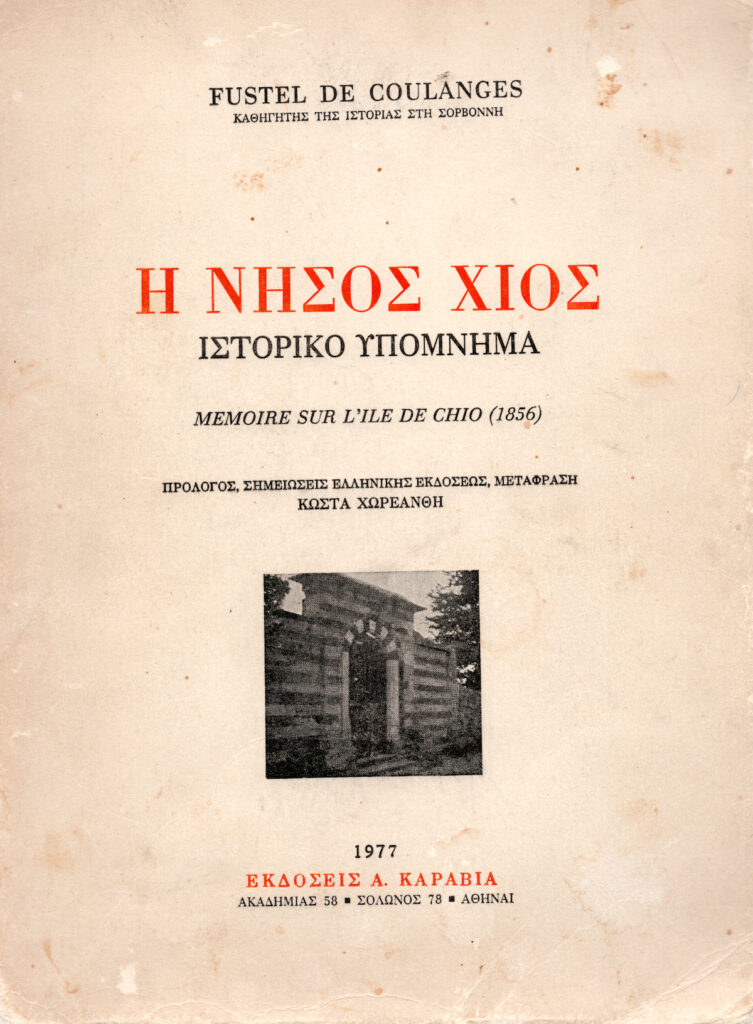Descriptions of Κambos by historical figures
Texts

“Chios’ Kambos is one of the strangest and most exclusive corners of the Greek land. You must imagine a vast piece of land, almost exclusively planted with lemon trees and their relatives: oranges, mandarins, bitter oranges. Some small olive groves scattered around. An abundance of flowers between the trees (I remember mostly the jasmines). But this fragrant forest is not easy to reach by the visitor. It is separated into orchards, surrounded by high red and golden walls. You can wander for hours around Kambos, among the walls, without seeing the forest, only breathing in its atmosphere. Suddenly a heavy door opens. The forest, finally, decides to reveal itself, rich, alive, moist with dew, full of murmurs and flutters. A shady paved path traversing the grass. A well creaking slowly and rhythmically. Water dripping on tiles, continuously. Inside the dense greenery, an old-fashioned house is hidden with worn bookshelves and melancholic portraits of 19th century maidens.
Kambos is the idyllic place of private life, of a reclusive, inner life, of fenced treasures, the place where one would like, in some moments, to remain for ever. But whoever goes up the terrasses of the old houses sees from above the big lemon tree forest, undulating, with the wind, like a green sea. And further away the real sea, the blue, towards infinity. And all this, calls for travels. And all this, calls for travels. “
George M. Theotokas, Extract from the travel guide, Chios

«I showed them the area Leukonia and the vessel directed there, followed by the other vessels… I knew the captain of the “Sapfo” from years ago… I showed him the spot where the river Kokalas flows into the sea and told him that in this place the waters were deep and the vessel could approach without fear, there was only sand on the seabed, so there was no danger for the boats. All the men were on the decks. As we approached, I recalled that there was a small Turkish guardhouse, built and coloured red according to the Turkish tradition, so I notified one boat to shoot at it with the steam cannon.
The position next to the estuary of Kokalas gave us the advantage that the vessels could get in proximity to the shore, because the waters were good, and the dinghies could get so close to the shore that the men could jump out of them without getting wet. Furthermore, along the beach there was a mound. It was created by an abandoned railroad, dating back to the time of the construction of the port of Chios, that was transferring stones from Aghios Konstantinos…”
George Choremis is an emblematic figure for Chios. He was an agricultural engineer and a wealthy businessman in Egypt. He created a unique estate close to Aplotaria. He had the honour to fight for the liberation of the island in 1912 and the talent to leave behind him a very detailed description of the businesses of Kambos, as well as unique details regarding the nearby beaches of Kontari and Leukonia.
Horemis I. Georgios, What I saw myself during the occupation of Chios by the Greek army. Biography of G. I. Horemis by the philologist Grigoris D. Spanos, Chios (alpha pi) 2002.
«The suburb found in the south of the city of Chios is called Kambos. It has beautiful orchards with lemon and orange trees and beautiful, pleasant houses. Its streets, however, are narrow and the walls high, which constricts the view. There is no running water there, only wells.
Many rural houses look like small medieval towers They are built of a tough stone and have a majestic staircase outside. On the first floor are the apartments and on the ground floor the stables, the dwellings of the superintendents and the servants, the wine cellars, the storage spaces.
Kambos has about 650 residences, some of them owned by the Ottomans. It is divided into three parishes.”
Campos in 1877 through the eyes of Dr. Adolphe-Louis Testevuide
Testevuide Ad., The island of Chios, Text and drawings from the magazine, Le Tour du Monde 1877,

«The most beautiful area of the island is the outskirts of the capital: this plain that spans for five square leagues is covered with orange trees. The mountains of Provatas, that rise in the centre of the island, run from southwest to northeast and reach the sea, approximately two leagues north of the city. In the south, they are cut vertically by a small eastbound mountain range that concludes at the cape of Aghia Eleni. These two mountains and the sea create a triangle, in the middle of which is the city. When, from a hill, you hug the area with your eyes, you will see a vast garden. Nature sometimes presents the most beautiful landscapes, not the richest. The sight, constricted by these three sides formed by the sea and the mountains, can only fall upon an endless growth of orange trees that are always green and always in bloom. From the sea, the traveller reaching Chios can see them climb up amphitheatrically for many leagues. Travellers confirm that in May, the whole island, the sea that surrounds it and even the Asian shores, are all flooded with the fragrance of the oranges. It is calculated that this plain produces sixty million oranges. The orange tree requires a lot of work and expenses for its cultivation; nevertheless, the net production per hectare of cultivated land with orange trees is estimated at around 1000 to 1200 francs.
When you come out of the city towards the south, you follow a road that after three leagues of distance is fenced with walls. There is a row of rural houses and gardens. The gardens of Chios are renowned; you will find there a few flowers, but no trees without fruit as in Europe; here, everything radiates less luxury and more wealth: they are just trees bearing fruit. A large well, dug deeply, gives water with a pulley turning with the power of a horse, and ditches distribute it to the roots of all the trees.”
Fustel de Coulanges, The island of Chios. Historical memorandum, Memoire sur l’ile de Chio (1856), Historical legend. Memoire sur l’ile de Chio (1856), prologue, notes of Greek edition, translated by Costa Choreanthi, Athens 1977, p.7.